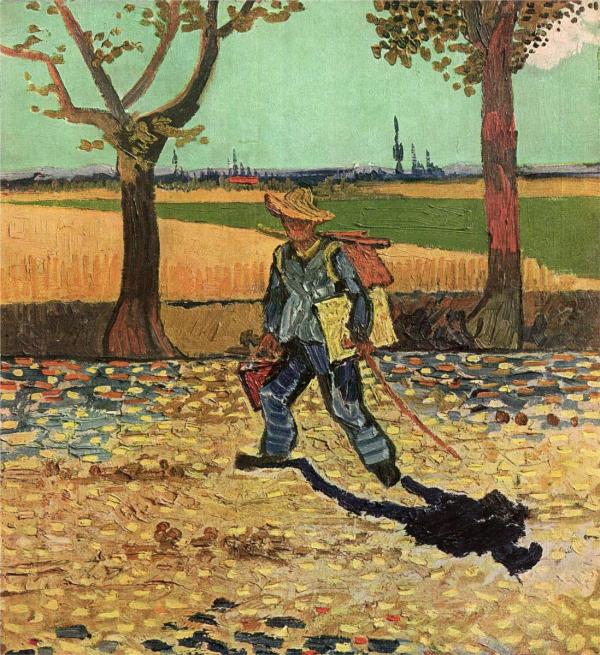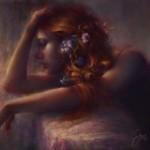The name Vincent Van Gogh is synonymous not only with the legacy of one of the greatest painters ever to have lived, but also with the tragic story of a life wrought with inner turmoil, struggle, and heartbreak. Van Gogh’s unfathomable talent for transforming the raw energy of his emotions into mesmerizing scenes on canvas is universally acknowledged, making his work the subject of fascination for generations of art enthusiasts.
One particular painting that encapsulates the essence of Van Gogh’s tumultuous and impassioned existence is the enchanting “Self-Portrait on the Road to Tarascon.” Created in 1888, this piece serves as an intensely personal window into the depths of the painter’s psyche. In the following article, we embark on a thrilling and soul-stirring exploration of this captivating masterpiece, venturing through the vivid tableau of colors, symbolism, and passion that defines Van Gogh’s Self-Portrait on the Road to Tarascon.

Historical Context
The year is 1888, and the small Provençal town of Arles in southern France is ablaze with golden sunlight. It is here, away from the harsh reality of Parisian life, that Vincent Van Gogh finds respite in the countryside, enraptured by its serene and bucolic charm. During his time in Arles, Van Gogh would paint some of his most iconic works – amongst which lies the enigmatic Self-Portrait on the Road to Tarascon. Incidentally, this period would also mark the beginning of the most turbulent phase of his life.
With the mesmerizing sunflower fields and picturesque olive groves as his muse, Van Gogh painted the Self-Portrait on the Road to Tarascon while walking along a tranquil path that traversed the countryside, leading towards the ancient town of Tarascon. Rendered in his signature Post-Impressionistic style, and recently having been influenced by the work of Japanese Ukiyo-e artists, Van Gogh’s piece pulsates with energy and movement, drenched in the vibrant hues of fields ablaze with summer’s waning glory.
A Frozen Moment in Time
The painting depicts the artist on his solitary journey, laden with his painting equipment and encompassed by the tranquil beauty of nature. In this candid snapshot of his life, Van Gogh appears to be momentarily pausing, his gaze captured by something – or someone – beyond the confines of the canvas.
Van Gogh is rendered in his emblematic cobalt blue smock, complemented by the swirls of yellow that frame his fiercely red hair and beard. His features, immortalized in meticulously crafted brushstrokes, appear contemplative and introspective, as if he has just been swept away by a fleeting moment of self-reflection.
The lush countryside that stretches out behind Van Gogh comes to life in vibrant greens and golden yellows, which are juxtaposed against the cerulean sky that provides an invigorating pop of color. The swirling patterns that compose the path, the foliage, and the clouds infuse the scene with an almost otherworldly energy – emblematic of Van Gogh’s breathtaking ability to intertwine the sublime with a world so seemingly mundane.
But amidst this vibrancy and revelry of color, there lies a subtle undercurrent of tension that permeates the air. A sense of unease haunts this otherwise harmonious depiction of the artist’s journey, encapsulating the duality of Van Gogh’s troubled existence.
Symbolism and Hidden Depths
A profound sense of isolation pervades the self-portrait, hinting at the loneliness and despair that haunted Van Gogh throughout his life. Despite being surrounded by the captivating beauty of nature, the artist appears lost in thought – as if isolated by an invisible, intangible barrier that separates him from the world beyond him. This representation of his own vulnerability and estrangement from the world resonates deeply with the struggles that Van Gogh faced throughout his tragic life.
Van Gogh’s choice to paint himself amidst the landscape, rather than in the solitude of his studio, is a poignant reminder of his deep-rooted connection with nature – an all-encompassing force that provided solace and inspiration in equal measure. The dynamic interplay between man and nature, immortalized on canvas, encapsulates the potent lifeforce that fueled Van Gogh’s creative genius.
Moreover, the self-portrait is drenched in symbolism and hidden depths that continue to enthrall and intrigue contemporary viewers. For example, the Hawthorn bush that features in the painting serves as an emblem of hope and protection that has been said to accompany wanderers on their journeys. Yet, the thorns that adorn the bush may also symbolize the suffering and hardships that Van Gogh faced on his turbulent journey through life.
The artist’s vivid blue smock is also imbued with deep significance. Frequently worn by laborers, the garment represents Van Gogh’s identification with the working class, highlighting his empathy and affinity for the everyday struggle of the common man.
The Legacy of a Lost Masterpiece
Tragically, Van Gogh’s Self-Portrait on the Road to Tarascon was fuelling the excitement of the 20th-century art scene, only to be forever lost. On August 22, 1944, the self-portrait, along with countless other notable works of art, was mercilessly devoured by the flames in an air raid by the Allied Forces during World War II. Housed in the Kaiser-Friedrich-Museum (now known as the Bode-Museum) in Berlin, the original painting now remains but a harrowing memory—a vivid, heartbreaking symbol of the ravages of war that not even the breathtaking beauty of art itself could withstand.
Yet, the enigmatic legacy of Van Gogh’s Self-Portrait on the Road to Tarascon persists. Photography, among other artistic mediums, lends a resilient and immortal soul to the once tangible piece of history; it maintains the magnetism and allure that sparked the indomitable allure of the original work. The painting continues to captivate modern audiences, appealing to the yearning for introspection, and providing a stark reminder of the struggles that every human soul endures on the journey called life.
Conclusion
Van Gogh’s Self-Portrait on the Road to Tarascon embodies the defining contradictions and complexities that have come to characterize the painter’s legacy. The vibrancy of its colors, the intensity of its symbolism, and the profound reflection it immortalizes all serve as powerful testimony to the unparalleled genius of Vincent Van Gogh.
Through the tendrils of isolation, anguish, and introspection that pervade the self-portrait, we witness a raw, unfiltered glimpse into the heart of a man who was, in every sense, chiseling away at the very essence of his own being. Passionately translatable in his every stroke, Van Gogh continues to be revered as an enduring legend of the art world — a testament to the boundless possibilities that lie within the intersection of talent, ambition, and the relentlessly human struggle for existence.


